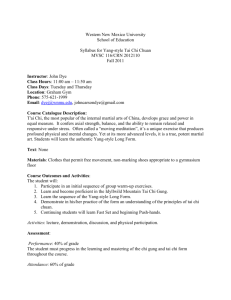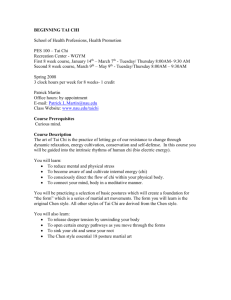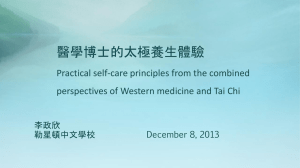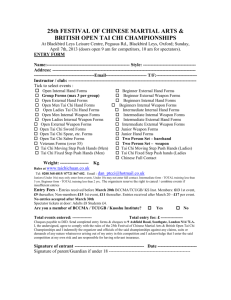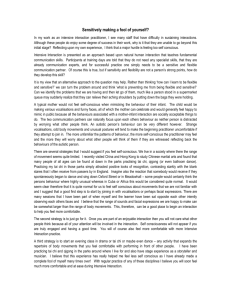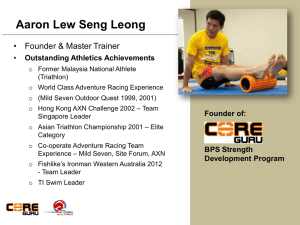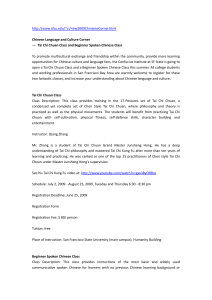File - Eyong E. Atem's E
advertisement
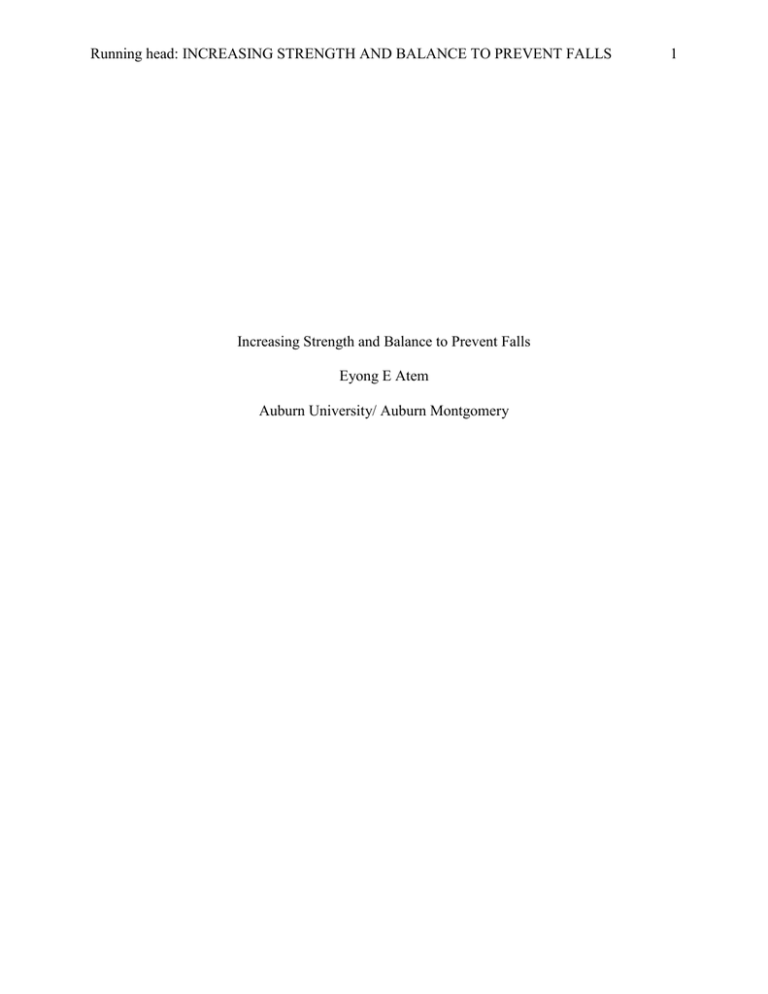
Running head: INCREASING STRENGTH AND BALANCE TO PREVENT FALLS Increasing Strength and Balance to Prevent Falls Eyong E Atem Auburn University/ Auburn Montgomery 1 Abstract As the average age of the population of American citizens continues to rise so does the incidence of falls among the older population. It is estimated that one out of three adults fall each year (Healthy People, 2013). The purpose of this project is to review available research on the effectiveness of tai chi to improve strength and balance and reduce the risk of falls in older adults. The target population is inactive community dwelling older adults age 65years or older who are at risk for falls. The ACE star model and Orem’s self–care deficit nursing theory are utilized for this project. The literature used is reviewed and appraised and recommendations for implementation are discussed. A pre-test was given to participants assessing their demographics, risk for falls, balance and strength. Participants were given a calendar log and encouraged to attend tai chi sessions at least 3 times a week. Follow up occurred at three weeks and calendar logs were checked. The number of time participants attended the exercise sessions, if they lost their balance, Berg balance scale and 30s CST pre and post tai chi were recorded in Excel and SPSS. Six participants were included in the project over he six weeks small test of change. Ninety percent of the participants performed exercise most of the times, there was increase in BBS score and 30s CST post tai chi and one fall was reported. All participants were able to voice an understanding of tai chi. Balance and strength did increase; however, further implementation is warranted with evaluations conducted every three months over a year to evaluate long term effectiveness. While these findings demonstrate some improvement in strength and balance in participants, they also support the belief that more research is needed to determine full possible advantage of tai chi exercise. INCREASING STRENGTH AND BALANCE TO PREVENT FALLS 3 Introduction According to the Centers for Disease Control and Prevention, the United States is on the brink of a longevity revolution. As modern medicine continuous to progress in the 21st century, America’s aging population continues to grow. By 2030, an estimated one in five Americans will be 65 years or older. The Department of Health and Human Services Administration (AOA), 2010 states that the aging population represents 12.9% of the population and is expected to grow to 19% by 2030. Based on the adults greater than 65 comprising of 1/8 of the population, healthcare providers have to become more acquainted with best current practice patterning to care of older adults. Historically, falls have been accepted as normal accidents and an unavoidable problem of advancing age or illness. However, thanks to a large body of evidence– based research over recent years, falls are now considered events that can be largely predicted and prevented (Pountney, 2009). Unfortunately, when they acquire disabilities, there is often not enough support available to help them. Despite aging being accompanied by a precarious decline in a multitude of physiological functions, a decrease in physical activity can increase the rate of this decline. A fall is a significant health problem among older adults. Falls in the elderly are not only associated with fall related injuries and a decline in health but have a great impact in health care costs (Harling & Simpson, 2008). Balance has been shown to decrease with age. However, some aspects of balance can be improved by Tai chi. Exercise is not only imperative to health but also to the functioning of older adults. The use of tai chi to increase strength and balance will be used to establish the best practice available to promote strength and balance and reduce the risk of falls in community-dwelling older adults. INCREASING STRENGTH AND BALANCE TO PREVENT FALLS 4 Significance In recent years falls in older adults have become an increasingly important public health issue. Approximately 30% of people age 60 years and older will fall in any 12-month period. Physical activities enhancing balance and strength are among the most promising intervention strategies for preventing falls in older adults (Kenny et al., 2011). The advantage of physical activity as a fall prevention strategy is that physical activity has many health benefits and can form a component of an individual healthy lifestyle rather than targeting one particular health problem (Voukelatos, Cumming, Lord, & Rissel, 2007). Tai chi is an ancient traditional Chinese martial art that includes smooth constant and intensely choreographed movement combining unilateral and bilateral shifting of weight together with trunk and extremity rotation (Leung, Chan, Tsang, Tsang, & Jones, 2011). Tai chi combines diaphragmatic breathing and relaxation with slow, gentle movement both isometric and isotonic. To perform tai chi participants should learn under the supervision of an instructor who is trained to monitor participants. Participants step with full weight on both lower extremities, but the heel strike is gentle (Kutner, Barnhart, Wolf, McNeely, & Xu, 1997). Tai chi includes five different styles: Chen, Yang Wu/Hao, Hu and Sun. In spite of the differences in style, training approaches and movement type, the fives styles are built on the same principle of using controlled muscle relaxation in generating leverage (Leung et al., 2011). During tai chi practice, practitioners do not surpass a maximum oxygen level of 55% and a maximum heart rate of 60% thus making tai chi a moderate intensity exercise that can be practiced by community dwelling older adults (Leung et al., 2011). INCREASING STRENGTH AND BALANCE TO PREVENT FALLS 5 PICO Question After learning the significance of decreased strength and balance in older adults, a PICO question was formed to further research the problem. The PICO question states, “In community-dwelling adults 65 years or older who are still physically active, what is the evidence that tai chi exercise as compared to other exercise can help improve strength and balance and thereby decrease the risk of falls and improve a person’s quality of life?” Population. Older adults 65 years or older who are physically active and living in the community Intervention. Tai chi exercise. Comparison. Other exercise results such as stretching, jogging and walking Outcome. Strength and balance, risk of falls and quality of life. Purpose The purpose of this project is to review and appraise the best evidence associated with tai chi and its efficacy in increasing strength and balance to reduce the risk of falls in community dwelling adults 65 years or older. To determine if tai chi used to maintain or improve balance and strength would have a greater impact on fall reduction in community dwelling older adults, the best evidence will be reviewed. Falls are a major health concern among older population and sustaining a fall may lead to different negative outcomes. The use of tai chi may help reduce the risk of falling and also improve patients’ outcome in different areas such as increase socialization and quality of life. INCREASING STRENGTH AND BALANCE TO PREVENT FALLS 6 Evidence-Based Practice Framework Evidence-based practice (EBP) is key to delivering the highest quality of healthcare and ensuring the best patient outcomes (Melnyk & Fineout-Overholt, 2011, p. 3). EBP is defined as a systematic search for exceptional analysis and synthesis of most congruent and best research to answer a clinical question. This includes intrinsic evidence generated from outcomes management through patient assessment and evaluation and the use of available resources to achieve desired patient outcomes, patient preferences and values (Melnyk & Fineout-Overholt, 2011, p. 4). In developing an EBP, it is imperative to use a framework in order to guide implementation of an EBP project. There are different frameworks available such as ACE star model, John Hopkins Model, Iowa model and the Russworm model. Also, a theoretical framework in nursing can help put research into practice. For the purpose of this project the ACE Star Model will be utilized in applying EBP to the problem and Orem’s Self Care Theory will be used for practice guidance. ACE Star Model of Knowledge Transformation The ACE star model is an evidence-based practice model that furnishes a comprehensive structure on how to formulate EBP processes and concepts. The ACE star model harmonizes both old and new concepts of improving care into a whole and provides a framework with which to construct EBP processes and approaches. To start knowledge transformation, the ACE star has five different stages. The first stage is discovery stage. In this stage, new knowledge is discovered through the traditional research (Stevens, 2004). Research results are generated through the conduction of a single study. This stage builds the foundation for research about clinical actions. There has been discovery that decreased strength and balance in older adults increases the risk for falls (Muir, Berg, Chesworth, Klar, & Speechley, 2010). Evidence suggests INCREASING STRENGTH AND BALANCE TO PREVENT FALLS 7 that intrinsic risk factors form the basis of many falls. The impact of reduced balance, flexibility, muscle strength and endurance increases the risk of falls in older adults (Harling & Simpson, 2008). A study titled “ Balance impairment as a risk factor for falls in community-dwelling older adults who are high functioning.” The findings assessed that balance impairment was associated with increased risk of fall through one leg stance test and limited stability test. (Muir, Berg, Chesworth, Klar, & Speechley, 2010) The second stage of the ACE star is evidence summary but it is the first unique step in EBP. The task is to synthesize the core of research knowledge into a single meaningful statement of the state of the science. The most advanced EBP methods to date are those used to develop evidence summaries (Stevens, 2004). The second stage is also considered a knowledge generating stage that occurs simultaneously with the summarization. The third stage is translation and the fourth stage is integration. In the ACE star model the third and fourth stages go together since the fourth stage however is more complex as it requires matching the evidence to a setting. The transformation of evidence summaries into actual practice requires both stages of translation of evidence into practice recommendations and integration into practice (Stevens, 2004). According to a study, the interventions used to prevent falls in community dwelling older adults should include tai chi among other strategies (Gillespie et al., 2012). Clinical practice guidelines should be implemented within these steps for decrease strength and balance and falls. The final stage of the ACE Model is evaluation of patient outcomes and the impact on health. As knowledge is transformed through these five stages the outcome is quality improvement of patients’ health (Steven, 2004). In appraising evidence on tai chi and fall prevention, the ACE Star Model combines all the appropriate steps needed to coordinate the idea of best practice in using tai chi to improve strength and balance, reducing the risk of falls and improving quality of life in older adults. INCREASING STRENGTH AND BALANCE TO PREVENT FALLS 8 Conceptual Framework: Orem’s Self-Care Theory Orem’s theory has been one of the most widely used theories in nursing (Meleis, 2012). The idea of Orem’s Self -Care Deficit Nursing Theory (SCDNT) provides the examination of self care ability (Taggart, 2001). According to Meleis, 2012, the purpose of self-care is to maintain life, to keep the essential physical and psychic functions going and to maintain the integrity of a person’s function and development within the framework of conditions that are essential for life. Individuals can learn self-care practice through experience and education (Meleis, 2012, p. 208). Taking into account the increasing elderly population, healthcare professionals are increasingly concerned with promoting the self-care potentialities of older adults. A person can be most vulnerable when they are in situations outside their norm, making it important to care for that person in need and help them gain independence (Taggart, 2001). There is concern that self-care abilities of older adults are limited by lack of knowledge of exercise that might improve health and well being. A comprehensive self–care need is the capability to prevent accidents and sustain a normal life. Self-care agency is the capability to meet self-care needs (Taggart, 2001). There are many negative outcomes associated with falling. Patients can suffer from, social isolation, fear to ambulate and even feelings of helplessness (Taggart, 2001). Among Orem’s eight universals self-care requites prevention of hazards and promotion of functioning are included. Self–care theory states self-care is learned purposely, regulating the structure of human integrity, human development and functioning (Orem, 2001). The requites of hazard prevention and promoting function applies to this project of using Tai Chi exercise to maintain strength and balance to reduce the risk of falls. Many physical and psychological outcomes may result by having patients participate in self care interventions that INCREASING STRENGTH AND BALANCE TO PREVENT FALLS 9 can increase strength and balance while potentially reducing falls and increasing their independence. Decreased strength and balance leading to falls are associated with feeling a loss of personal independence, restricted social activities and a fear of falling, social isolation and increase in anxiety. Therefore using the ACE Star Model to will assist in guiding the EPB project by providing needed steps to use in discovering the best practice for increasing participants’ compliance in exercise regime that increase strength and balance, quality of life and reducing falls while Orem’s theory will aid with implementation of the project by having participants get involve in self care intervention such as tai chi that can increase strength and balance while potentially reducing falls. Review of Literature Melnyk and Fineout-Overholt, (2011) state that unlike research that has commonly practiced methods and the use of knowledge based on a single study, EBP takes into regard a blend of available evidence from many different studies. The blend is connected with the competency of the practitioners together with the patient’s values and what the patient likes (p.4). A broad literature search on Tai chi interventions to prevent the risk of falls in community dwelling older adults was made covering Medline, CINAHL, TRIP database, guideline.gov, Center for Disease Control and Prevention (CDC.gov) and the Cochrane Database for Systematic Reviews (CDSR) until January 31 2013. For all databases, the search strategy focused on systematic reviews randomized clinical trials (RCTs) and clinical practice guidelines. INCREASING STRENGTH AND BALANCE TO PREVENT FALLS 10 Factors Affecting Falls Falls can be defined as an unexpected event in which a patient comes to rest on the ground, floor or a lower level (Freibeger, Haberle, Spirduso, & Rixt zijlstra, 2012). Falls and its related physical and psychological events including injuries and decreased quality of life are generally known to be big health issues in older adult population (Freibeger et al., 2012). Approximately one third of adults 65 years or older falls at least once each year. Once an individual has fallen, the older adult is prone to fall again (Freibeger et al., 2012). Unfortunately, the incidence of falls in older adults increases with age and frailty. When a fall occurs, older adults are often reluctant to tell family members for the fear that they will be placed in a nursing home (Freibeger et al., 2012). A prospective study conducted by Muir et al. in 2010 to evaluate the independent contribution of balance assessment on future fall risks, a sample of 210 community-dwelling older adults were given a comprehensive geriatric assessment at baseline, which included the Berg Balance Scale to measure balance. At the end of the study, there was supportive evidence that balance impairment is a risk factor for falls in community dwelling older adults (Muir et al., 2010). Interventions to Prevent Falls A systematic review conducted by the Cochrane Collaborative evaluated the benefits of different interventions for preventing falls in community-dwelling older adults. In the systematic review the best evidence for the efficacy of interventions to prevent falling emanated from large, well-conducted randomized controlled trials or from meta-analysis of smaller trials (Gillespie et al., 2012). The systematic review by the database required identifying a large number of trials in fall prevention in community dwelling adults. The evidence is summarized for healthcare professionals, researchers, policy makers and others with an interest in the topic of falls INCREASING STRENGTH AND BALANCE TO PREVENT FALLS 11 (Gillespie et al., 2012). The clinical practice guideline included 159 trials with 79,193 participants. Most trials compared a fall prevention intervention with no intervention or an intervention not expected to reduce falls. The most common interventions tested were exercise as a single intervention with 59 trials (Gillespie et al., 2012). The review looked at the healthcare literature to establish which fall prevention interventions are effective for older people living in the community. It established that group and home-based exercise programs, usually containing some balance and strength training exercises, such as tai chi significantly reduce falls (Gillespie et al., 2012). Tai Chi Leung et al. conducted a systematic and meta-analytical review in 2011 to determine if tai chi can improve balance and reduce fall rate in older adults. Thirteen randomized controlled trials were used in the review that examine the effectiveness of tai chi on balance improvement and fall reduction in older adults (Leung et al., 2011). The study findings reported that tai chi was effective in improving balance in older adults but it was not superior to other interventions. However, in the absence of other interventions tai chi reduced falls in older adults (Leung et al., 2011). Taylor et al., (2012) conducted a randomized control trial to determine the effectiveness of tai chi as an intervention to prevent falls in community- dwelling older adults The trial was conducted across eleven different locations in New Zealand between June 2006 and November 2008 with 684 community-dwelling adults with a mean age of 74.5 (Taylor et al., 2012). The results of the trial suggested that providing a community based fall prevention exercise such as tai chi for older adults would significantly improve strength and balance but will not support fall reduction. In addition, the idea of group exercise improved social engagement. Thus the act of tai chi as an exercise regimen not only increased balance and strength but also social well being of INCREASING STRENGTH AND BALANCE TO PREVENT FALLS 12 participants (Taylor et al., 2012). In 2007,a randomized control trial to determine the effects of tai chi on health related quality of life in senior population was conducted among 140 seniors in Taiwan (Ho et al, 2007). The results of the trial supports the hypothesis that tai chi improves quality of life among the elderly with the tai chi group having significantly higher score in general health, social functioning and vitality compared to control group (Ho et al, 2007). A clinical practice guideline included tai chi as an intervention to help prevent falls in community dwelling adults (Kenny et al., 2011). Exercise is one of the strong recommendations by the panel members. In the guideline specific programs recommendations include balance, gait and strength training, whether in groups or as individual at home using an exercise regimen such as tai chi to achieve the goal of fall prevention (Kenny et al., 2011). The clinical practice guidelines created to provide a stimulus for widespread use of effective, evidence-based fall prevention services for older adults and to increase public awareness of the benefits of such preventions. According to Kenny et al, 2011, having certain physical attributes such as weak legs, poor muscle strength, poor balance and stability, and limited mobility have been found to negatively impact gait and increase the risk of falling. However, since strength, muscle mass, gait, balance and stability are all closely interlinked, many exercise intervention programs such as tai chi which is a strengthening exercise as well as balance and stability training aids in preventing falls among community dwelling older adults. Tai chi exercise regimen used even among frail older adults who are relatively weak has proven to increase muscle strength, core balance and gait (Kenny et al., 2011). According to the guidelines, preventive services that increase strength, balance and gait such as tai chi will result in a reduction in the incidence of falls and will maximize functional and quality-of-life outcomes (Kenny et al., 2011). INCREASING STRENGTH AND BALANCE TO PREVENT FALLS 13 To determine the best practice intervention to reduce fall rates in community dwelling adults who are not involved in any moderate or strenuous exercise, a randomized control trial in recruited participants 70 years and above from a legacy health system in Portland, Oregon (Li et al., 2005). Intervention for the treatment group consisted of one hour of tai chi training three times a week for twenty-six weeks while the intervention for the control group consisted of stretching exercises (Li et al., 2005). At the end of the study it was noted that fall rates were significantly reduced in the treatment group compared with the control group (Li et al., 2005). Another randomized control trial was conducted to determine if tai chi as an intervention was effective in reducing falls for community dwelling older adults (Voukelatos et al., 2007). The intervention consisted of having a sixteen weeks community based tai chi exercise program of at least one hour three times a week. Falls were measured during sixteen weeks and twenty-four weeks post intervention (Voukelatos et al., 2007). Findings in this study included that falls were less frequent in the tai chi group compared with the control group, and also significant change in balance favoring the tai chi group (Voukelatos et al., 2007). A systematic review conducted by Harling & Simpson in 2008 to determine the effective of tai chi in reducing falls and fear of falling in older adults using randomized controlled trials. Seven randomized control trials were used and findings indicated strong supportive evidence of tai chi to reduce the fear of fall but were not effective in reducing fall rates (Harling & Simpson, 2008). In summary, while other fall prevention approaches do not target older adults with decrease strength and balance, a focus was given to participants who needed to improve on their independence by improving strength and balance (Muir et al., 2010). Using an exercise approach such as tai chi to target this problem can prove very effective in preventing falls (Gillespie et al., 2012; Kenny et al., 2011; 2012; Li et al., 2005). According to Voukelatos et al., (2009), there is a INCREASING STRENGTH AND BALANCE TO PREVENT FALLS 14 clear association with decreased strength and balance and falling. It is important to implement effective interventions into practice settings to increase elder strength and balance and prevent adverse outcomes from occurring. Critical Appraisal of Evidence There have been many research articles related to using tai chi and falls, but not all are able to provide evidence of best practice. Many articles were reviewed and appraised to determine the efficacy in using tai chi as an intervention to prevent falls in community- dwelling older adults. The purpose of this project is to answer the question, “ In community dwelling adults 65 years or older what is the evidence that tai chi compared to other exercises will help in improving strength and balance and thereby reduce the risk of a fall and improve patient quality of life?” One prospective study (Level IV evidence) was evaluated to verify balance impairment as a risk factor for falls in community older adults (Muir et al., 2010). In this study it was noted that balance decreases with age, which is a big issue related to falls in older adults (Muir et al., 2010). One systematic review (I evidence) was evaluated related to falls and fear of falling in institutionalized older adults (Harling & Simpson, 2008). In the review, fall rates did not improve but fear of falling did improve. One Systematic Review (SR) (level I evidence), one Clinical Practice guideline (CPG) (level I evidence) and two Randomized Controlled Trials (RCT) (level II evidence) were evaluated related to the effectiveness of tai chi as an intervention used in reducing the risk of falls (Gillespie et al., 2012; Kenny et al., 2011; Taylor et al., 2012; Li et al., 2005). In three of the four studies, there was a reduction in falls when tai chi was used as an intervention. However, one of the RCTs concluded that tai chi is effective in improving strength and balance in older adults but not effective to use as a fall reduction program. One other RCT (Level II evidence) INCREASING STRENGTH AND BALANCE TO PREVENT FALLS 15 and one SRs (Level I Evidence) were reviewed and all two of these articles looked at effectiveness of tai chi specifically and its correlation to fall prevention (Leung et al., 2011; Voukelatos et al., 2007). The appraisal of many literature sources regarding falls shows that tai chi, lack of exercise, decreased strength and balance are all factors related to falls. The use of tai chi to increase strength and balance will be used to establish the best practice available to promote strength and balance, reduce the risk of falls and improve quality of life in community dwelling older adults. These studies overall revealed a direct correlation of tai chi with fall prevention in community dwelling older adults. From the studies mentioned above, further appraisal of evidence including findings, purpose of studies, intervention, validity outcomes, strength and weakness can be found in Appendix A. Recommendations Falls remain a significant issue in our community. Based on the literature review, the following recommendations can be made. It can be see through the literature discussed in this paper that fall prevention programs can be effective; however, they may also need additional preventive measures. Even though there are different methods used to prevent falls in community dwelling older adults, there are also different methods used to prevent fall but sometimes the same method does not work for all. Performing tai chi exercise to prevent falls has been demonstrated as effective in increasing strength and balance and prevent falls in community dwelling adults and the outcome outweighs harm. It is given a recommendation of A (Gillespie et al., 2012; Kenny et al., 2011; Leung et al., 2011). Utilizing tai chi as an intervention to increase strength and balance thereby reducing falls is recommended and given the grade A, since there is good evidence found within literature that tai chi increases strength and balance (Li INCREASING STRENGTH AND BALANCE TO PREVENT FALLS 16 et al., 2005, Voukelatos et al., 2007). In order for tai chi to be maximized, the participants should be willing to change lifestyle and become involved in caring for themselves. One suggested way to changing lifestyle is a have a regular schedule to attend tai chi exercise or perform it at home in order to increase strength and balance. Fall prevention still remains a health care issue and further research is recommended to be able to use the best evidence possible. A great amount of literature can be found on fall prevention alone and tai chi. Although further research is still needed in demonstrating more effective interventions; the majority of evidence demonstrates that tai chi is one effective intervention for reducing the risk of falls in community older adults. Implementing a communitybased exercise program such as tai chi will increase strength and balance and ultimately reduce falls among community dwelling older adult population. Needs Assessment Implementation of an exercise regimen to prevent falls will take place at a senior citizen center in southwest. Currently, the senior citizen center has an exercise program tai chi; however, there is no assessment of tai chi participants outline within this program to examine if there is improvement in strength and balance, and if it improves quality of life for participants. Summary of Participants Data Participants’ seen at the senior center is comprised of older adults living in the community above the age of fifty. The senior center sees about seventy five to on hundred senior citizens per week (Dana Stewart, personal communication, August, 2013). Due to advanced age seen within this population group, most of them are at increased risk for decrease strength and balance, falls and decreased quality of life. Upon conclusion of the implementation of increased compliance and frequent assessment of the tai chi participants within the exercise program, the INCREASING STRENGTH AND BALANCE TO PREVENT FALLS 17 numbers will be compared to see if there is an improvement in strength and balance, improvement in quality of life and decrease in the number of falls. Key Stakeholders Within the senior center, there are several key stakeholders to aide in implementing the findings into practice. The special programs coordinator, the tai chi instructor and the risk management team are the key stakeholders in allowing the implementation at the senior center. Staff members are also key stakeholders in that they will be of great help keeping track of falls that occur while participants are in the center. The tai chi instructor who is also an occupational therapist will be able to ask participants questions if they have experienced any fall while at home during the project and after the project. The Instructor, programs coordinator and staff members will keep each other accountable for the implementation and evaluation. Stakeholders realize a need for more attention to decrease strength and balance related problems and are willing to help in seeing if increase compliance and frequent assessment of participants will help the senior citizens prevent falls while out in the community. The current state within the senior center is on the right track with fall prevention; however, there is room for improvement. With implementing a compliance program and frequent assessment during tai chi exercise, it is intended that the senior center will see improvement in the fall rate within the center and at home by seeing an improvement in strength and balance of participants. This can be possible with the participation of the key stakeholders. Implementation Plan Implementation of Evidence Based Practice (EBP) into any setting can be challenging, making it very important to follow a specific plan while aiming to change practice. Implementation for the EBP project will be piloted to raise awareness of the benefits associated INCREASING STRENGTH AND BALANCE TO PREVENT FALLS 18 with tai chi and compliance with actually performing the exercise. Permission will be obtained prior to implementation from the Institutional Review Board (IRB), the senior center, the tai chi instructor and the participants involved. A permission letter will be developed for participants informing them of what is expected through the implementation process and possible benefit from the project with increase compliance and frequent assessment. Selected Intervention Voukelatos, Cumming, Lord, and Rissel (2007) found that there is an association with decreased strength and balance and falls; therefore, intervention will aim at improving strength and balance to ultimately reduce the potential for falls. According to Li et al, 2005 and Gillespie et al, community dwelling older adults who participate in tai chi exercise reported an improvement in strength and balance as well as their quality of life as compared to those who do not. Education plans for implementation will be taken from a randomized controlled trial previously discussed. The MSN student will visit the participants at the senior center every two weeks to follow up on any improvement that may have occurred or on any falls that may have occurred. Falls affect many older adults, specifically those in the community with that said, the selected intervention for community dwelling older adults will be implementing regular assessment into tai chi program to see if there is any improvement in strength and balance, reduced risk of falls and improvement in quality of life Implementation Process Following permission for implementation, the senior center and the prospective participants for implementation of the project, the participants who meet the inclusion criteria stated in the PICO question will answer questions on a short pre-test form. The pre-test will be questions asked on a simple fall risk sheet. Questions asked will include participant age, any INCREASING STRENGTH AND BALANCE TO PREVENT FALLS 19 medical history, history of previous fall, any fear of falling, how loosing balance and strength affect them, how falls may affect participants, before the session has participants heard of tai chi and any suggestions they use to help prevent falls while out in the community. Following fall risk assessment and successful PAR-Q exercise readiness screening, baseline assessment will include pretesting using the Berg Balance Scale (BBS) and the 30 Second Chair-Stand-Test (30s CST). The BBS was developed as a clinical measure of functional balance specifically in older people. Suggested applications were comparing balance between groups of people, describing balance in an individual, monitoring status over time, and evaluating treatment effectiveness. 30Seconds Chair Stand Test (30-s CST). Active people perform moving from a sitting position to a standing position daily, and significant functional limitations can occur when the ability to rise from a seat is impaired. It measures lower body strength and relates it to the most demanding daily life activities such as climbing stairs, getting out of a chair or bath tub or rising from a horizontal position. The 30-s CST consists of standing up and sitting down from a chair as many times as possible within 30 seconds. A standard chair (with a seat height of 40 cm) without a backrest but with armrests will be used. Participants will be seated on the chair with their back in an upright position. They will be instructed to look straightforward and to rise after the “1, 2, 3, go” command at their own preferred speed with their arms folded across their chest. Participants will be educated on tai chi; questions and concerns will be answered before classes begin. A log was given to participants as a reminder keep a record of the number of times exercise was performed weekly and if they experienced any loss of balance or falls. Education plans for implementation will be taken from a randomized controlled trial previously discussed, the participants will attend tai chi three times a weeks for at least an hour each session with frequent follow-ups (Voukelatos et al., 2007). The MSN student will visit the INCREASING STRENGTH AND BALANCE TO PREVENT FALLS 20 participants at the senior center every three weeks to follow up about teaching and any improvement that may have occurred or if any fall has occurred. A randomized controlled trail to determine if tai chi as an intervention was effective in reducing falls for community dwelling older adults by Voukelatos, Cumming, Lord and Rissel, 2007 and another randomized controlled trial conducted by Li et al, 2005 will help guide implementation of the EBP project. The tai chi instructor will instruct participants on how to perform tai chi. Participants will be encourage to attend tai chi session at least three times a week for at least one hour each session (Voukelatos et al., 2007). In order to monitor falls, participants will be given a spreadsheet log and will be told to place a tally mark in the box everyday they perform exercise, loose balance and/or if experienced a fall. The more tally mark in the column under tai chi exercise and the fewer tally marks in the decrease strength and balance, and fall category, the greater the chance that a change is happening. Sheets will be used to keep tract of the number of times exercise is performed, number of falls, number of time participants experiences balance problems and it will also allow the setting to compare numbers quarterly. This will consist of checking the logs to see if the participants are being compliant with filling them out and to monitor participants’ progress. A final evaluation of the log will be completed at the end of tai chi session. Information sheet will be given to participants at the end of the session to reiterate tai chi exercise so that participants may refer back to it for question or if they need to perform the exercise while away from the center. Staffs will be informed of the implementation process and will be expected to aide in asking participants to complete log and also to be available if participants have a question or concern. The project should increase participants’ compliance and satisfaction with exercise, and also increase strength and balance. INCREASING STRENGTH AND BALANCE TO PREVENT FALLS 21 Facilitators and Barriers A major facilitator to implementing this project in this setting is the special programs coordinator who is very willing to spend time answering questions when they arise and in a timely manner. Another facilitator is, there is already a tai chi instructor who is also an occupational therapist is readily available to teach participants. The tai chi instructor has certified in tai chi for more than ten years and is also willing to spend time with me explaining the various techniques used. Someone employed by the senior center will be available between the hours of 8am and 5pm to help answer questions that may arise from participants. According to Melnyk and Fineout-overholt, 2011, changes that are piloted on a small scale that have commitment to better practice with staff opinion can encourage positive attitude with engagement for new and improved practice. A potential barrier identified may be the participants’ not comfortable answering questions especially if they have experienced a fall or fall related injuries that they might find to be personal or embarrassing. To help solve this problem it is the responsibility of the MSN student to fully explain the implementation process through better communication or even through the use of handout. Again, if the staffs are not willing to help facilitate, then are in turn a potential barrier to implementation. Therefore keeping staffs involved with the project and continuously updating them could help with implementation. Through out the implementation process, barriers will be reevaluated if needed, and solutions made. INCREASING STRENGTH AND BALANCE TO PREVENT FALLS 22 Resources Several resources will be used to effectively implement the project. Available resources are the tai chi instructor, the special programs coordinator and the risk management team. Another resources available are a computer to log in data, type questionnaires and a printer to print out questionnaires and assessment tools. The prospective budget for the project will be small. Computer technology to create permission forms, pre and post test, information sheets and log will be downloaded onto MSN student’s computer; therefore no financial burden. Paper and ink to print forms will be approximately twelve dollars with a rim of paper costing approximately three dollars and ink cartridge costing approximately seven dollars. Time budgeted for the implementations in the senior center will approximately twenty-four hours between pre test, post-test and follow-ups. In the case that enough time has not been allocated to make sure everything is on par, the MSN student will adjust accordingly. Evaluation Plan In order to effectively determine if the project has made change on the target population, proper evaluation measures must be taken. The purpose of this project in the long-term aspect is to determine if strategies are used to maintain or improve strength and balance, would there be a greater impact in preventing falls with more than not incorporating those strategies. For the purpose of the project, the short-term outcomes of this project are to increase compliance and satisfaction with performing exercise. Also, another short-term outcome is to assess if tai chi increases strength and balance. Long-term outcomes of the project are to continuously increase strength and balance of participants, prevent the number of falls associated with decrease strength and balance, and improve quality of life. Older adults should be encouraged to speak up about history of falls and if they begin to loose their balance. A goal will be to have older adults INCREASING STRENGTH AND BALANCE TO PREVENT FALLS 23 participant increase compliance in fall prevention program that incorporates tai chi exercise. This project will address the need to have an exercise program that has been demonstrated to be effective in improving strength and balance and decreasing the risk for falls in the community dwelling older adults Descriptive population data Important population data that will be included in the project will be age, gender, race, living arrangement, history of falls, fear of falling, gait and balance measured every three weeks. Also, participants’ compliance with program and quality of life will be included. Methods used to collect data Questionnaires, assessment tools, and face-to-face interview with participants will be used to collect data. The Berg Balance Scale (BBS) used to assess balance and functional mobility in elderly individuals consists of fourteen items that are scored on a five-points ordinal scale will be used to measure balance in participants. Quality of Life (QoL) will be measured with the EuroQol EQ 5-D a descriptive system that comprises 5 dimensions as mobility, self care, usual activities, pain/discomfort, anxiety/depression, each dimension has 5 levels: no problems, slight problems, moderate problems, severe problems, and extreme problems. Fall rates will be measured using a fall calendar. Learning outcomes for the project will be measured using a post-test that will determine if the teaching has been met. The MSN student will measure if learning and compliance outcome has been met if the participants states on the post-test that learning has occurred and can actually demonstrate effective techniques used in the tai chi exercise. Participants will be required to fill out log every time exercise is performed. The primary outcome will be to measure if there is any new fall accidents. The BBS to measure balance and the EuroQol EQ 5-D to measure quality of INCREASING STRENGTH AND BALANCE TO PREVENT FALLS 24 life will be measured at baseline and three weeks. At the end of the baseline measurements participants will receive a fall calendar made of fall and no fall column. They will be asked to fill in daily if they experience any fall. Outcomes will be measured by tally marks on a spreadsheet log under the appropriate column. If they are tally marks on the fall column then the short-term outcome of strength and balance will not have been met. Statistical Package for the Social Science (SPSS) will be used to compare the number of times tai chi exercise was performed, number of times a participant losses their balance and any falls at the beginning and at the end of exercise program. The SPSS will be used to evaluate if there has been an overall positive effect of the project. If there are few incident reports filled out by the center or if few senior citizens report falls then satisfaction will have been met. Stakeholders will be kept informed of the progression of implementation and will be encouraged to remain involved. Cost will be examined throughout implementation to ensure that there it is not over budget. A record will be kept to measure all expenses of the project implementation. Project Timeline The timeline for the small test of change was approximately six weeks. Beginning the first week of February, permission forms were given to prospective participants and then pre-test given following obtained permission. Follow up with participants on February 25, 2014 to assess progress and to check calendar logs. Logs were checked to see if participants have logged any falls, loss of balance with falls and loss of balance without falls. Six weeks after the completion of tai chi session balance was reassessed using the Berg Balance scale and strength was reassess using the 30s CST. Exercise sessions were progressing as expected and participants were filling out logs as educated. INCREASING STRENGTH AND BALANCE TO PREVENT FALLS 25 Budget Along with the relatively small timeframe, the prospective budget for the small test of change is also small. Computer technology to create permission forms, pre and posttest, logs were downloaded onto the MSN student’s computer; therefore, no additional payment was needed to get materials needed. Paper to print off forms was approximately fifteen dollars. Gas needed to travel to and from senior center was approximately five dollars. Discussion of Small Test of Change Within the small test of change, the ACE Star Model was utilized for implementing the change, specifically the steps of translation of findings and integration into practice (Stevens, 2004). The small test of changed measured to see if there will be an increase in strength and balance if participants attended tai chi exercise sessions. Implementation took place February 6, 2014 through March 13, 2014. Data was entered into Excel spread sheet and analyzed SPSS statistics package at the completion of small test of change to determine if the implementation was effective. The intervention group consisted of six adults both men and women age 65 and older that attend Hubert and Grace senior center. Participant demographics varied with age, gender, living arrangements (see Table 1). INCREASING STRENGTH AND BALANCE TO PREVENT FALLS 26 Table 1. Participant Demographics After the MSN student recorded participant demographics, following fall risk assessment, PAR-Q+ exercise readiness, and pretested with Berg balance scale and the 30s CST, MSN student and tai chi instructor answered questions from participants before exercise sessions began. Tai chi sessions were encouraged to be performed at least 3 times a week and a calendar log given to participants and the tai chi instructor documented attendance. SPSS was utilized to determine the percentage of participants that attended tai chi most of the times or some of the times. Ninety percent of participants attended tai chi most of the times (see table 2). Table 2. Tai Chi Attendance Tai chi performed Most of the times Some of the times 90% 10% Prior to implementation, participants were asked if they have ever loose their balance, fallen with or without bruising or injury. The graph shows comparison of pre and post loss of balance with or without falls and from the graph there was improvement loss of balance, and no post fall with bruising or injury (see figure 1) INCREASING STRENGTH AND BALANCE TO PREVENT FALLS 27 Figure 1 Pre and Post fall data Pre and Post Fall Data Pre Tai Chi No loss of balance or falls some loss of balance no falls Post Tai Chi loss of balance and loss of balance and fall minor fall no bruising with burising or injury or injury Prior to implementation, the participants were pre tested to know their BBS score and 30s CST scores. These score were recorded in order to evaluate the effectiveness of tai chi in increasing strength and balance (see Figure 2). Figure 2. Comparing Means of Berg Balance Scale and 30s CST pre and post Tai Chi Comparing means of Berg Balance scale and 30s CST pre and post Tai Chi 50 n=6 40 30 BBS pre TC 20 BBS Post TC 10 30s CST pre TC 0 30s CST post TC BBS pre TC BBS Post TC 30s CST pre TC 30s CST post TC BBS t=-2.800 p=.038 30sCST t=-4.540 p=.006 As seen in figure 2, BBS score mean increase from 40.63 to 45.33 and 30s CST increase in post implementation from 13.17 to 17.50, indicating that tai chi exercise can help in improving strength and balance in community dwelling older adults 65 years and older. INCREASING STRENGTH AND BALANCE TO PREVENT FALLS 28 From the implementation, it can be seen that BBS t=-2.800 p=. 038, showing the results were significant in improving balance and 30sCST t=-4.540 p=. 006 showing the results were significant in improving strength. Although the senior center still does not have official falls score for the quarter in which implementation took place, it is known that there was one reported fall among the participants with bruising. Ultimately, this shows that it is possible for tai chi to increase strength and balance and prevent falls that community older adults could experience, and also that participants’ quality and safety outcomes were met as well by not having any adverse event occur while performing tai chi. A few other outcomes were met with this small test of change. Participants being able to perform tai chi exercise without instructor met the learning outcome of increased awareness of tai chi as evidence. One participant had difficulty performing exercise accurately while the other ninety percent were able to perform exercise correctly. Behavioral outcomes were met as evidenced by participants changing their typical daily routines by integrating tai chi into activity of daily living. Having all the participants performing tai chi with ninety percent performing tai chi most of the times evidenced this. Overall, all outcomes were met within the small test of change. There was an improvement in BBS score and 30s CST; one fall was reported with minor injury and learning did occur. However, there can also be further recommendations for implementation to better the outcomes in the future. Future Recommendations In order to improve the implementation in the small test of change, it is recommended to implement this test of change over a longer period of time. A longer duration for follow up would prove to assist in tracking changes. Another recommendation would be to have a larger INCREASING STRENGTH AND BALANCE TO PREVENT FALLS 29 participants group to be able to implement the exercise regimen. Further implementation is warranted with evaluations conducted every three months over a year to evaluate long-term effectiveness. Tai chi classes should be focused on improving strength and balance in community dwelling older adults, and should have regular review, progressions and adjustments as needed. While these findings demonstrate some improvement in strength and balance in participants, they also support the belief that more research is needed to determine full possible advantage of tai chi exercise It is also recommended that strength and balance should be focus of the fall prevention within the community in which the MSN student carried out the small test of change, All in all, the small test of change was successful, and by incorporating these few recommendations, the final results could reach optimal potential. Conclusions In conclusion, the small test of change revealed that Tai chi can improve strength and balance and fall rates can decrease within the community by adding an exercise program. Based of the data, it was determined that community older adults were willing to incorporate tai chi exercise into their routines. Key learning experience the MSN student experienced includes discovering how to plan an intervention for a small test of change and implement the outlined intervention. Also, being able to utilize Excel spread sheet and SPSS statistics to determine if the small test if change was effective. For an advanced practice nurse, one most be able to research data, interpret the data, and then ultimately incorporate any changes needed into practice. By doing this the advanced practice nurse will stay up to date on the most current treatment and evidenced based practice for patients, allowing the patients to have the best health care outcomes. The MSN student was also INCREASING STRENGTH AND BALANCE TO PREVENT FALLS 30 able to refine skills in effectively educating participants not only about the ramifications of fall, benefits of exercise but the importance of preventing falls instead of being treated for falls. This project enhanced the MSN students’ abilities in research and implementation and proved to be effective within the small test of change. Knowledge improved for both the participants and the student. Strength and balance improved there was just one fall reported among participants and outcomes of improving strength and balance were met. The EBP project proved to be a successful learning experience for the MSN student as well as the participants. INCREASING STRENGTH AND BALANCE TO PREVENT FALLS 31 References Administration on Aging: Department of Health and Human Services (AOA). (2010). Aging Statistics. Retrieved from http://www.aoa.gov/AoARoot/Aging_Statistics/index.aspx Berg Balance Scale (2010) Retrieved from http://www.uwo.ca/actage/conferences/conference2012/Berg%20Balance%20Scale.pdf EuroQol EQ 5-D (2013). Retrieved from http://www.euroqol.org. Freibeger, E., Haberle, L., Spirduso, W. W., & Rixt Zjlstra, G. A. (2012, March). Long-term effects of three multicomponent exercise interventions on physical performance and fallrelated psychological outcome in community-dwelling older adults: A randomized control trial. Journal of American Geriatric Society, 60(3) 437-446. doi: 10.1111/j.15325415.2011.03859.x Gillespie, L. D., Robertson, M. C., Gillespie, W. J., Sherrington, C., Gates, S., Clemson, L. M., & Lamb, S. E. (2012, September 12). Interventions for fall prevention in community dwelling older persons. Cochrane Database of Systematic Review, 19(CD007146). doi: 10.1002/14651858.CD0007144.pub3 Harling, A., & Simpson, J. P. (2008). A systematic review to determine the effectiveness of Tai Chi in reducing fall and fear of falling in older adults. Physical Therapy Reviews, 13(4), 237-248. doi: 10.1179/1743288o8x309241 Ho, T., Wen-Miin, L., Lien, C., Ma, T., Kuo, H., Chu, B., & ... Lin, J. (2007). Health-related quality of life in the elderly practicing T'ai Chi Chuan. Journal Of Alternative & Complementary Medicine, 13(10), 1077-1084. doi:10.1089/acm.2007.0518 Kenny, R. M., Rubenstien, L. Z., Tenetti, M., Brewer, K., Cameron, K., John, D.,...Suther, M. (2011). Summary of the updated American geriatric society/British geriatric society: INCREASING STRENGTH AND BALANCE TO PREVENT FALLS 32 Clinical practice guidelines for preventing falls in older person. Journal of American Geriatric Society, 59(1), 148-157. doi:10.1111/j.1532-5415.2010.03234.x Kutner, N. G., Barnhart, H., Wolf, S. L., McNeely, E., & Xu, T. (1997). Self-report benefit of tai chi practice by older adults. Journal of Gerontology: Psychological Science, 52b(5), 242246. Retrieved from www.EBSCOhost.com Leung, D., Chan, C., Tsang, H., Tsang, W., & Jones, A. (2011). Tai Chi as an intervention to improve balance and reduce falls in older adults: A systematic and meta-analytical review. Alternative Therapies in Health and Medicine, 17(1), 40-48. Retrieved from http://search.ebscohost.com/ login.aspx?direct=true&db= cin20&AN= 2011186253&site= ehost-live Li, F., Harmer, P., Fish, K., McAuley, E., Chaumeton, N., Eckstrom, E., & Wilson, N. (2005). Tai chi and fall reduction in older adults: A randomized controlled trial. Journals of Gerontology Series A: Biological Sciences and Medical Sciences, 60A(2), 187-194. Retrieved from http://search.ebscohost.com.spot.lib.auburn.edu/login.aspx?direct=true&db=cin20&AN= 2009070904&site=ehost-live Meleis, A. I. (2012). Theoretical Nursing Development and Progress (5 ed.). Philadelphia, PA: Lippincott Williams & Wilkins. Melnyk, B. M., & Fineout-Overholt, E. (2011). Evidence-Based Practice in Nursing and Healthcare: A guide to best practice (2 ed.). Philadelphia: Lippincott Williams & Wilkins. INCREASING STRENGTH AND BALANCE TO PREVENT FALLS 33 Muir, S., Berg, K., Chesworth, B., Klar, N., & Speechley, M. (2010). Balance impairment as a risk factor for falls in community-dwelling older adults who are high functioning: A prospective study. Physical Therapy, 90 (3), 338-347. doi: 10.2522/ptj.20090163 Orem, D. E. (2001). Nursing: Concept of practice. 6th Ed. London: Mosby Pountney, D. (2009). Identifying and managing the risks of fals in nursing home. Nursing and Residential care, 11(2), 618-620. Retrieved from http://web.ebscohost.com Stevens, K. R. (2004). ACE Star model of EBP: Knowledge transformation. Academic Center for Evidence-based Practice. In The University of Texas Health Science Center at San Antonio. Retrieved from www.acestar.uthscsa.edu Taggart, H. M. (2001). Self- reporting benefits of tai chi practice by older women. Journal of Holistic Nursing, 19(3), 223-232. doi:10.1177/0898010101011900303 Taylor, D., Hale, L., Schluter, P., Waters, D. L., Binns, E., McCracken, H.,...Wolf, S. L. (2012, may). Effectiveness of tai chi as a community-based prevention intervention: A randomized controlled trial. Journal of American Geriatric Society, 60(5), 841-848. doi: 10.1111/j.1532-5415.2012.03928.x Voukelatos, A., Cumming, R. G., Lord, S. R., & Rissel, C. (2007, August). A randomized controlled trial of tai chi for the prevention of fall: The central Sydney tai chi trial. Journal of the American Geriatric Society, 55(8), 1185-1191. doi: 10.1111/j.15325415.2007.012

